 Expedition No.2 saw the Urban Repairs Club departing the City of Birmingham promising we would return; six months later, on the summer solstice 2012, we did. The plan: to check out a few more of the Birmingham Big City Plan’s six defined quarters for the outward growth of Birmingham city centre.
Expedition No.2 saw the Urban Repairs Club departing the City of Birmingham promising we would return; six months later, on the summer solstice 2012, we did. The plan: to check out a few more of the Birmingham Big City Plan’s six defined quarters for the outward growth of Birmingham city centre.
Our December 2011 trip incorporated a brief dig into Digbeth and swift sojourn in Southside; on this trip (20-21 June 2012) we headed for the north-west side of the city centre. Basing ourselves in the Colmore Business District, we took a walk on the Westside, and put the Jewellery Quarter under the magnifying glass.
Our aim to make a fuller tour of Digbeth was timed out for a second time, and so will have to wait for another trip. And why not? Birmingham is well worth many a return visit – and the large area covered by the Big City Plan (800 hectares, divided into seven quarters: the city core plus six areas for expansion), means that they will be needed. So, hopefully, not so much a game of two halves, as one of many quarters.
“Westside” was previously known as “the Convention Quarter”, and we spoke last time of the City Council’s shrewd policy to develop Birmingham as Britain’s second city for professional conferences, which dates back to 1987. We arrived in some respects as the fulfilment of the Economic Development Department’s original dream: two out-of-towners coming up to a three-day national conference, with money to burn and a thirst to sample the city’s cultural and leisure offer for a long, balmy midsummer evening.
As we dodged the blustery showers and the addicts receiving paramedic attention in St Philip’s Cathedral yard, and then struggled with the giant self-check in screens, security pass-operated doors and Silk Cut cigarette-themed décor of the City Centre Premier Inn, it was fun to reflect on how we were indeed living 1987’s dream of what 2012 Birmingham could be like, and yet how the future always turns out to be somewhat more mundane than originally expected.
The city’s strategy for transformation set out on the late 80s/early 90s was bold, and has been largely successful. Indeed, in many different ways the Birmingham of 2012 has seen changes that far exceed anything that the planners of that period could have dared imagine in their wildest dreams. Yet the fundamental dream of Birmingham transforming to an elegant, modern European city at ease with herself, feels somewhat unfulfilled. Digging in to why that should be is, in retrospect, one of the things this expedition was all about.
1. Arrival in the CBD
The expedition commenced at Birmingham Snow Hill station, which was described in Expedition No.2. This time we had more time to inspect the new Snow Hill development on railway land adjacent to the station, and the wider area around it that has been branded “the CBD”, or Colmore Business District.
Colmore Row is one of Birmingham’s finest streets and leads from Snow Hill to the Town Hall, forming en route the north side of the cathedral square, Birmingham City Centre’s largest green space. The CBD is the city centre’s traditional premium office quarter, and stands apart from the main shopping streets. It has recently been restored to the top of the premium office heap by the giant Snowhill office development, on the far side of the station, which is part-finished.
“One Snowhill” is a rather gross and overbearing glass fortress, squashed onto its site. Built by Irish developer Ballymore and funded by the insanely reckless Anglo-Irish Bank, it is hard to find out if One Snowhill is one of the lunatic investments that led to that bank’s downfall/bail out and the penury of the Irish people. However, it does appear to have been sold at a loss to the German Commerzbank Group.
Kings of the castle are accountants KPMG, who have taken it as a suitably prestigious base for such leading lights of the Birmingham corporate social scene (see “reflections on the Birmingham Post” below). The next phases (Two Snowhill, etc) are under construction, and Birmingham’s first five star hotel and a new Midlands HQ for Barclays Bank are promised.
The cathedral square is a perfect contrast. It and Colmore Row were laid out in the 18th century by the fast-growing industrial town as a new district, away from the medieval muddle of the Bull Ring. St Philip’s Cathedral, which is a lovely example of English baroque, was completed in 1715 and replaced St Martin’s in the Bull Ring as Birmingham’s parish church. It was elevated to cathedral status in 1905.
Today it provides a welcome civilising influence on the central business district, with its churchyard a rare green space free to enjoy. It provides a useful downtown meeting place for young unemployed Brummies, who would be chased out of the private “public spaces” of Snowhill by CBD’s private security guards. They appear to use it as a good place to drink al fresco until you pass out. We passed two casualties, who were being attended to by paramedics. Despite this, the space was pleasant, not at all threatening and was clearly being enjoyed by all walks of Birmingham life.
2. Evening in the Jewellery Quarter
Our evening tour began with what it is becoming the Urban Repairs Club’s traditional fruitless quest round the newsagents of Birmingham for an A-Z, or any street map of the city. For some reason they are impossible to find. However, the shop assistants of Birmingham are so generous with their time, and so solicitous of your wellbeing, that the doomed quest is almost a pleasure anyway. It’s a way of re-introducing yourself to the West Midlands: a gentler, kinder place than London – although not necessarily one where you can get your business done quickly. A young Asian-British Brummie disappeared off for ten minutes and came back trying to give us his own personal copy of a Great Britain road atlas, as his best shot at helping us out. We retreated, without the map, but with a copy of the weekly Birmingham Post.
We decided to navigate by the sun, the stars, and the city council’s numerous 1990s-vintage cast iron pedestrian route signs, and set off for the Jewellery Quarter anyway.
The Quarter is separated from the city centre/CBD by the inner ring road, city centre’s notorious “concrete collar”. On Expedition No.2 we inspected the city’s attempts to loosen its collar at Moor Street and the Bull Ring. But at Snow Hill you can see the collar (at this point the A38 Great Charles Street Queensway) in its original untamed form – and it is indeed formidable. On this part of the Queensway there are emphatically no surface pedestrian crossings, and so we went under it via the claustrophobic, classically 1960s subway at Livery Street.
And so we emerged into the Jewellery Quarter at about quarter to seven on a June evening. Hometime had clearly been and gone, and barely anyone was around. A couple of unhinged-looking young men passed by and, fresh from the narrow subway, the thought suddenly struck: is it necessary to worry about mugging risk around here? Then, hang on – are those two girls stood on the corner waiting for a bus, or streetwalkers? Hey (came the thought), what kind of nickel and dime joint is this quarter?
This is precisely the kind of user reaction that the Big City Plan is anxious to prevent, by improving the walking route from the city centre. An at-grade pedestrian crossing of Queensway is promised “in the long term”, as soon as “an innovative design solution” is found. Meanwhile, a new Jewellery Quarter exit from Snow Hill station has already been introduced, and this is a very welcome improvement.
However, it had already closed for the evening by the time we arrived. In fact most things on Livery Street were shut, except for Lituanica, a Lithuanian grocery. A nice little business, purveyors of a wide range of pickled vegetables, but, no, they did not sell a Birmingham A-Z.
Onward, and things started to look up very quickly. Any sense of threat soon evaporated as it became clear that the Jewellery Quarter is a perfectly safe place to walk around, and the feeling transformed into an increasing sense of delight, as the evidence mounted up that the Quarter is a very special place indeed.
The area that is now the Jewellery Quarter played a big part in Birmingham’s transformation from nondescript Midlands village to wonder-city of the Industrial Revolution. The area was gradually developed in the Georgian era on land belonging to the Colmore family. The area’s specialism was not so much precious stones and jewellery, it was fine metalwork and metal-bashing. The key products were brass buttons, cap badges, medals, and – at Matthew Boulton’s steam-powered Soho Mint in nearby Handsworth – coins of the realm for Great Britain, and for export to many other realms worldwide.
The key to understanding Birmingham and the Jewellery Quarter’s heritage is not to see it as a place which was ever based on the exquisite hand-craftsmanship of luxury items à la Paris, but rather as the place where the mass production of affordable products for the mass market was invented. Nathaniel Winkle’s self-designed Pickwick Club coat button embossed “P.C.” was a typical Brummagem product (the button responsible for him being challenged to a duel in Chatham by Dr. Slammer of the 97th Regiment, in a case of mistaken identity).
The quintessential Jewellery Quarter architecture is not only that of the townhouse-cum-workshop (although very many excellent examples of these exist), but also that of the medium-sized factory. Some of factories are Victorian masterpieces, like the 1863 Albert Works (now the Argent Centre), but others are 20th century, such as Taylor and Challen’s on Water Street, currently being used as a car park.
We followed Water Street, running parallel to the Birmingham & Fazeley Canal, to Ludgate Hill, the Quarter’s main restaurant drag. A number of café-bars and restaurants have built wooden decks out into the street for outdoor seating and pot plants, which successfully create a continental feel. Sadly though, even on the eve of the longest day, it wasn’t really warm enough to sit out on them in great comfort, and virtually nobody was. Slightly more disconcertingly, a number of the restaurants and bars were pretty quiet on the inside as well. We chose Locanta, an Italian-Turkish restaurant, which did seem to have a buzz going on inside.
Locanta is in a typical Jewellery Quarter townhouse with a typical Jewellery Quarter history: we were told that it had been a thimble factory, a jewellery workshop, then a tailoring business (which had done work for the Queen), before being left empty in 1996. Locanta’s owner, a cartographer from Izmir who had come to Birmingham in 1990 to study, had bought the place in 2002 and converted it himself into a restaurant. It had good food and the relaxed but efficient atmosphere of a well-run independent family business.
We discussed the state of trade with the owner. His perception was that the recession had dented weekday evening trade, as people pulled in their horns and restricted their going out to the weekend. But he also was strongly of the view that, as a place for dining out within Birmingham, the Jewellery Quarter was, if not exactly failing, in need of a boost to give it a greater critical mass as an evening out destination.
Later, we spoke to Jamie and Katie, a young Brummie couple resident in the Quarter and working in the city centre hotel trade; they were among the few enjoying a bottle of wine al fresco on the decking. They had only praise for the Jewellery Quarter, which they thought was great for them, with reasonably priced rents, and an atmosphere and flavour that were a big change in the right direction from the Birmingham council estate where they had grown up. They were so kind and delightful that you just wanted to give them a big hug.
After dinner we went to admire St Paul’s Square, another wonderful Georgian square with church and churchyard in the middle (1771, spire added 1821), on the same model as the cathedral square. The church looked quiet, so we broke in and ascended up the back stairs to the balcony, only to find that a full orchestra and choir were in the full flow of some kind of modern classical music/dance fusion performance downstairs. Despite there having been no indication on the outside that anything was going on inside, the downstairs pews were almost full. We assumed we had stumbled in on some kind of diabolical secret society, and crept out, unnoticed.
We escaped to the Rope Walk pub on St Paul’s Square, and staked the place out from the outdoor balcony seats. We tucked in to a pint of bitter and a packet of Q Scratchings (a local Black Country delicacy), and waited for clues. The congregation eventually emerged, jumping into cars and melting into the night. Not one came into the Rope Walk, proving beyond reasonable doubt to us that some kind of black Mass had been going on. (We later discovered it was a dress rehearsal for an event at the Symphony Hall the following night.)
Nothing in our subsequent nocturnal ramble to check out estate agents windows, factory to residential conversions (“Maxim”, “Aqua@20 Lionel St”), creative industry business premises (Radio Kerrang! 105.2FM) and boutique hotel developments (Bloc hotel, Caroline Street) could match this level of excitement, and so we retired back to the CBD.
3. Day 2: Westside, Brindleyplace
We breakfasted at Fumo on the cathedral square, and then went to our conference in a hotel on Broad Street, in the area the Big City Plan calls “Westside”, and which had previously been dubbed The Convention Quarter, containing as it does the International Convention Centre on Centenary Square and numerous large hotels.
Centenary Square and Broad Street
Centenary Square (1988) was one of the first city council-led big splash redevelopments that followed its bold decision to remake the city and bust out of the 1960s concrete collar. At this location on the collar (the big Paradise Circus/Queensway junction), the concept was to create a chain of civic squares in a line from the city centre: Victoria Square, Chamberlain Square, Centenary Square. In moving between the three, you would hardly notice you were crossing the concrete collar.
This was achieved by means of a new footbridge and a glazed atrium (“Paradise Forum”), forming an addition to the 1974 brutalist Central Library building. Undoubtedly the 1988 scheme is now tired and the link between the three squares should be improved; however, there is great controversy about how.
The city council’s solution is to demolish the 1974 Central Library and redevelop the whole of Paradise Circus. The library itself is being replaced by the enormous new Library of Birmingham building on Centenary Square, which is currently in construction. This has provoked an architectural preservation debate, with modernists attempting to save the old library building as a classic of its brutal genre, whilst also deploring the vacuous design of the new library.
It’s a fascinating scrap, no doubt provoking wry smiles from the original Betjeman generation of preservationists, who had to do battle with the brutalists back in the 1960s. It’s not the Urban Repairs Club’s job to get too involved with this kind of architectural fight (or, we might say, circus). We would just say that the democratic ideals of brutalist architecture are already coming back into fashion, and one can easily see the argument that demolishing the old library now would be looked back upon from the future as a mistake.
Could it be possible to do a similar job on the old library as has been done on the National Theatre in London? If the clutter of concrete walkways could be cleared out, and the dire Paradise Mall removed, the building could be given a bit of a space. And maybe then it would come to be appreciated at last, as the once hated “nuclear power station” National Theatre now is. However, in practical terms, it may well be that a new use for the building is impossible. Which is a shame, because certainly one has zero confidence that its replacement is likely to be any better as architecture.
As for the new library, it may well be an impressive building inside when finished. Outside it appears to be a very big box with fancy cladding, very much from today’s dominant “they said they wanted iconic and it was easy to do in the CAD package, so we built it” school of architecture. Without question, it will totally dominate Centenary Square when finished. Looking on the bright side, it will at least be a public library.
On the south side of Centenary Square runs Broad Street, a historic commercial street which found itself rather cut off following the construction of the concrete collar. The architectural approach to the revitalisation of Broad Street has allowed a lot of new build, in addition to conservation and restoration. It clearly has been a commercial success, with a number of significant investments by major business hotels. We had mixed views on its success in aesthetic and architectural terms, which broadly can be summarised as not too bad considering what it had been, but some missed opportunities and plenty of room for further improvement.
Contemporaneous with Centenary Square was Birmingham’s celebrated rediscovery and regeneration of its extensive canal network and canalside (more miles of canal than Venice etc), centred on the Gas Street Basin. The junction of the Birmingham Mainline, Birmingham & Fazeley and Birmingham & Worcester Canals forms an irresistibly charming focus for any re-use you might have cared to imagine. Even the pretty mundane shed architecture of the 1991 National Indoor Arena and Sir Norman Foster’s 1996 National Sea Life Centre or the can’t dent the charm of the waterside, the narrowboats and Matthew Brindley and Thomas Telford’s ironwork and canal engineering features.
Brindleyplace
We then entered the 1995-2000 Brindleyplace development (masterplanned by Sir Terry Farrell). Of all the things we saw in Westside, it was the place we decided we liked the least, right down to its absurd and already dated running of two words together.
Were we being unreasonable? Of the many “new ruins of Great Britain” dating to the Blair era, it is not the worst. The main square could be seen as a decent-enough effort, surrounded by modern office buildings of inoffensive design (which happen to be among the most prestigious in the city). The square itself is of reasonable proportions; it has a well-tended lawn, informal seating, a “percent for art” sculpture, a health and safety compliant water feature and pavement cafés with outdoor seating galore: every box ticked.
We decided it was a soulless hell, and that the contrast with the cathedral square bequeathed by the city’s founding fathers 200-250 years ago could not be more shaming to our own era.
In the upper floor of the offices of Deloitte Touche and Tohmatsu Ltd, accountants, shone a neon sign, another modern artwork, which said: “Love is a…”. This small feature seemed to sum up all the awful examples of attempts to garnish a big money property development with silly bits of this, that and the other, and it became the focus of our dislike for Brindleyplace. Whatever love is, we decided, it is not “percent for art” and it is not Deloitte’s in Brindleyplace.
4. The Jewellery Quarter (north)
Returning to the Jewellery Quarter along the towpath of the Birmingham and Fazeley Canal, the happy flowerbeds of Groundwork UK’s offices by Cambrian Wharf marked the boundary where we felt a soul started to return to the cityscape. The 1980s era flats along the canal, unusually, looked to be aging gracefully, and appeared lived-in and cosy.
We re-entered the Jewellery Quarter at Charlotte Street, with the aim of visiting its northern part, along Frederick Street and Vyse Street.
Our first call was the Argent Centre, originally the Albert Works pen factory, built in the style of a Lombardian palazzo, and home of the truly delightful Pen Room museum. The real charm of the museum is found in the volunteer staff (old chaps in overalls, who look like they may have once worked in the factory), and in the displays by the Birmingham Calligraphy Society, really showing what can be done with a good old fashioned nib and ink.
The rest of the factory is let out as business space by its owners, the Midlands Industrial Association, who had displayed this admirable mission statement on their noticeboard: “The Midland Industrial Association Ltd’s aim is to promote employment and fight dereliction through the encouragement of the small firms sector, by providing suitable workspace through the refurbishment of redundant buildings”. We can only applaud.
Frederick Street and Vyse Street are the centre of the modern day jewellery and precious metals trade. There are a number of manufacturing jewellers, many of whom have entered into the retail trade with enthusiasm (it is worth remembering that the Jewellery Quarter was exclusively a manufacturing district right up to the late 1970s; before that, there were no retail jewellery shops at all in the Quarter). There is a thrilling atmosphere of real trade being done, bargains to be had and deals to be struck, with the possibility of blags and ram raids not too far away.
Along Frederick Street we spotted Thomas Fattorini Ltd’s badge and medal works, Purefine Assayer and Refiners, Bullion Store, Dealers Refiners and Pawnbrokers. On Vyse Street, British Clockcase Ltd – the home of quality barometers, GL Bicknell & Sons manufacturing jewellers, Weston Beamor Ltd Jewellery Services Group. This active commerce is mixed in with traditional pubs and vaguely upmarket new café-bars and restaurants in various types of premises: we spotted Vertu Bar, Frederick’s Lounge & Bar and the Portofino Bar. On Hockley Street, the Jewellers Arms and the Drop Forge Restaurant & Bar.
The junction of Vyse St, Frederick St and Warstone Lane, which has the 1903 “Chamberlain Clock” as its centrepiece, has more the look and feel of a normal Birmingham suburban centre than does the unique St Paul’s Square. It has busy car traffic – all going far too fast – and a Tesco Express. It also has “the Big Peg”, a 1971 tower or “flatted factory” that was built to modernise the workshop premises available to Jewellery Quarter businesses. It still provides business space and has the Jewellery Quarter visitor information booth in front of it.
Unfortunately we were unable to ask how the current recession/depression was affecting the jewellery and precious metals trade – the information booth was closed. But it looked to us like the trade will survive; indeed those in the scrap gold business may even thrive.
We actually worried more for the yuppie-orientated independent café-bars and restaurants that had sprung up on the streets around the Chamberlain Clock: are there too many such places now for the age of austerity? Too late to ask: it was time for us to return to London, and, passing the 18th-19th century Pitsford Street graveyard, we left by train from Jewellery Quarter station, back to the city centre and, from there, London Marylebone.
5. Reflections on the Jewellery Quarter
 Although it is fun to go to Westside and take the opportunity to slag off the likes of Terry Farrell or Norman Foster, or to wade into rows between the 20th Century Society and Birmingham City Council, the mission of the Urban Repairs Club is to try to understand the delicate ecosystem of places like the Jewellery Quarter, to ask what lessons it has for other places interested in organic urban regeneration – and to dare to venture a few modest ideas for urban repairs we would like to offer to make the place even better.
Although it is fun to go to Westside and take the opportunity to slag off the likes of Terry Farrell or Norman Foster, or to wade into rows between the 20th Century Society and Birmingham City Council, the mission of the Urban Repairs Club is to try to understand the delicate ecosystem of places like the Jewellery Quarter, to ask what lessons it has for other places interested in organic urban regeneration – and to dare to venture a few modest ideas for urban repairs we would like to offer to make the place even better.
Therefore, as we headed back to London, we tried to put our finger on what it was that made us like the Jewellery Quarter so much, and what the best response to the current recession – which is no doubt hurting those who have invested in the Jewellery Quarter quite badly – might be. Only then did we allow ourselves to reflect on Birmingham more widely, and have that go at One Snowhill, Brindleyplace, KPMG, Deloitte, Terry Farrell and all their ilk, through the means of a rumination on the Birmingham Post.
 Unquestionably the Jewellery Quarter is a very special place. The first special ingredient is the raw material of the inheritance of buildings and townscape. The quarter was laid out in the early industrial revolution, in the Georgian and Regency era, before the high Victorian mix of pomp and utilitarianism took over. The surviving buildings, streets and squares of this era have an elegance lacking in high Victorian, more reminiscent of the Hope Street area of Liverpool than anything Manchester has to work with. St Paul’s Square epitomises this, and is a real gem.
Unquestionably the Jewellery Quarter is a very special place. The first special ingredient is the raw material of the inheritance of buildings and townscape. The quarter was laid out in the early industrial revolution, in the Georgian and Regency era, before the high Victorian mix of pomp and utilitarianism took over. The surviving buildings, streets and squares of this era have an elegance lacking in high Victorian, more reminiscent of the Hope Street area of Liverpool than anything Manchester has to work with. St Paul’s Square epitomises this, and is a real gem.
 Birmingham was a cradle of the factory system, but the badges and buttons metal bashing trades did not require enormous fortresses. So, from the high Victorian Lombardian palazzi right through to the early 20th century factories and the 1971 Big Peg, all fitted into the fine grained street pattern – meaning that regeneration when it came needed to be done on a building by building, block by block basis, rather than on the giant blank canvas of a razed ex-heavy industrial or docks site, on which so many of the “new ruins of Great Britain” have been built.
Birmingham was a cradle of the factory system, but the badges and buttons metal bashing trades did not require enormous fortresses. So, from the high Victorian Lombardian palazzi right through to the early 20th century factories and the 1971 Big Peg, all fitted into the fine grained street pattern – meaning that regeneration when it came needed to be done on a building by building, block by block basis, rather than on the giant blank canvas of a razed ex-heavy industrial or docks site, on which so many of the “new ruins of Great Britain” have been built.
The area did not require a Daniel Libeskind-style arsehole starchitect, it required a good, old-fashioned Gavin Stamp-style conservation officer. This appears to be what it got, and the City Council and English Heritage deserve much credit for showing this wisdom. A fair balance has been struck, allowing admirable small entrepreneurs, such as Locanta’s owner, to get ahead with building conversion and re-use, whilst restraining them enough within a framework of conservation rules to ensure that the unique spirit of the townscape has been retained. The odd error has been made, but in general, the new build (of which there has been quite a lot) fits in with the townscape. The names of the heroes of this process remain unknown to us, which is a shame, but also somehow fitting to the successful guiding philosophy of modesty.
 The second special thing about the regeneration of the Jewellery Quarter – setting it utterly apart from so many other regeneration projects in the industrial cities – is that its raison d’etre still exists. Although the Jewellery Quarter has done a good job of the conventional urban regeneration pitch – the conversion of former industrial space to bars, cafes, restaurants, yuppie flats, start-up space for creative industries and so on – the fact that it remains a genuine centre for jewellery manufacturing adds immeasurably to its charm.
The second special thing about the regeneration of the Jewellery Quarter – setting it utterly apart from so many other regeneration projects in the industrial cities – is that its raison d’etre still exists. Although the Jewellery Quarter has done a good job of the conventional urban regeneration pitch – the conversion of former industrial space to bars, cafes, restaurants, yuppie flats, start-up space for creative industries and so on – the fact that it remains a genuine centre for jewellery manufacturing adds immeasurably to its charm.
 We would love to believe that in the new Jewellery Quarter there is room not only for the cheap end volume trade (the area’s traditional strength), but increasingly a shift towards the craft and designer end of the market. The Quarter already tries (but could perhaps do even more) to develop the concept that for your significant purchase, be it a wedding ring or a quality barometer, provenance matters. So, not only can you get a good range of choice and a good price in the Jewellery Quarter, you can seek out the designer and craftsman of your piece, perhaps even see it being made. It’s a pitch that gives the area an almost unique chance to defy the seemingly inevitable outsourcing of virtually all manufacturing production to China.
We would love to believe that in the new Jewellery Quarter there is room not only for the cheap end volume trade (the area’s traditional strength), but increasingly a shift towards the craft and designer end of the market. The Quarter already tries (but could perhaps do even more) to develop the concept that for your significant purchase, be it a wedding ring or a quality barometer, provenance matters. So, not only can you get a good range of choice and a good price in the Jewellery Quarter, you can seek out the designer and craftsman of your piece, perhaps even see it being made. It’s a pitch that gives the area an almost unique chance to defy the seemingly inevitable outsourcing of virtually all manufacturing production to China.
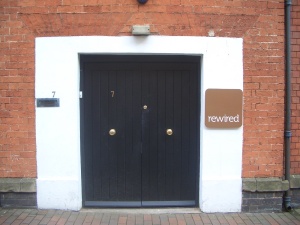 The stroke of genius in giving an important continuing role for manufacturing in the area’s regeneration is that the conventional mix of yuppie regeneration isn’t carrying all the burden of making the area feel special. The Jewellery Quarter seemed to us mostly to avoid giving off the feeling (which one often gets in Manchester and Liverpool) that the whole “trendy area” regeneration thing is all rather brittle. Because it has quality, and seems at ease with itself, the Jewellery Quarter isn’t plastered with public art and interpretation boards telling the visitor that the area is unique and fascinating; it just is unique and fascinating.
The stroke of genius in giving an important continuing role for manufacturing in the area’s regeneration is that the conventional mix of yuppie regeneration isn’t carrying all the burden of making the area feel special. The Jewellery Quarter seemed to us mostly to avoid giving off the feeling (which one often gets in Manchester and Liverpool) that the whole “trendy area” regeneration thing is all rather brittle. Because it has quality, and seems at ease with itself, the Jewellery Quarter isn’t plastered with public art and interpretation boards telling the visitor that the area is unique and fascinating; it just is unique and fascinating.
Which brings up the third special thing we felt about the Jewellery Quarter, which is that it is a success, but mercifully not too much of a success. It has been saved, but it hasn’t been ruined.
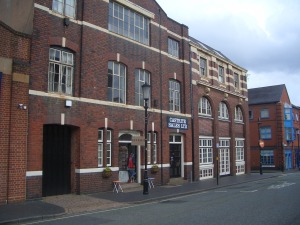 Our cartographer restauranteur at Locanta identified that the area has not achieved what he described as critical mass. To which we say, in a reply which may seem rather harsh to small businesses hard-pressed by the recession: good. The Jewellery Quarter is currently full of small independent businesses, and the best of them, such as Saint Caffe on St Paul’s Square, set a tone of quiet quality. In physics the effect of achieving critical mass is a chain reaction, and we fear the same thing could happen to the Quarter: all the landlords jacking up the rents and replacing today’s preponderance of independents with Caffe Nero, All Bar One, Giraffe and all the usual suspects.
Our cartographer restauranteur at Locanta identified that the area has not achieved what he described as critical mass. To which we say, in a reply which may seem rather harsh to small businesses hard-pressed by the recession: good. The Jewellery Quarter is currently full of small independent businesses, and the best of them, such as Saint Caffe on St Paul’s Square, set a tone of quiet quality. In physics the effect of achieving critical mass is a chain reaction, and we fear the same thing could happen to the Quarter: all the landlords jacking up the rents and replacing today’s preponderance of independents with Caffe Nero, All Bar One, Giraffe and all the usual suspects.
For us the Jewellery Quarter is perhaps – and we would welcome local expert views on this – one of the quintessential battlegrounds in England between two fundamentally different views of what urban regeneration is and is for.
 We guess there are two tribes of investor in the Jewellery Quarter: those who are committed to Birmingham’s heritage and its regeneration, and want to experiment with creating a genuine urbane Birmingham for the 21st century, and those who want a quick return – to pump up and surf a real estate phenomenon, then sell out to the big boys and get their profits out quick to the surrounding shires, where they really want their personal investment and lifestyle to be.
We guess there are two tribes of investor in the Jewellery Quarter: those who are committed to Birmingham’s heritage and its regeneration, and want to experiment with creating a genuine urbane Birmingham for the 21st century, and those who want a quick return – to pump up and surf a real estate phenomenon, then sell out to the big boys and get their profits out quick to the surrounding shires, where they really want their personal investment and lifestyle to be.
And then there are the big boys themselves, the funds and their professional advisers who create and inhabit the Snowhills and the Brindleyplaces, corporate giants whose blundering greed and myopia cannot help but ruin every place they touch.
 The future path of the Jewellery Quarter feels like a tightrope. On one side lies too much success (financially measured): achievement of critical mass and the “chain reaction” – leading to sell out and blandification. On the other, too little success and the loss of too many of the brave and exciting small businesses to austerity and impatient creditors, and the area’s special flame could go out.
The future path of the Jewellery Quarter feels like a tightrope. On one side lies too much success (financially measured): achievement of critical mass and the “chain reaction” – leading to sell out and blandification. On the other, too little success and the loss of too many of the brave and exciting small businesses to austerity and impatient creditors, and the area’s special flame could go out.
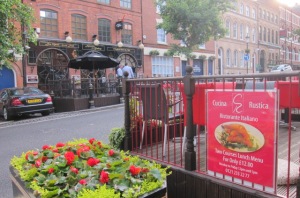 We think the secret to the Quarter safely staying on the tightrope is commitment to the place itself. What we would hope to see, and think the Quarter deserves, is a type of resident and business who love the place and want to put down roots and stay there for the long haul. It sounds almost ludicrous in a Birmingham context (though it would be second nature in Germany or Italy), but we would love to see young dinkies like Jamie and Katie, when the time comes and they have kids, decide that they are simply refusing to leave for the suburbs or shires, and instead insist on the Quarter maturing into a proper urban village where you can raise a family.
We think the secret to the Quarter safely staying on the tightrope is commitment to the place itself. What we would hope to see, and think the Quarter deserves, is a type of resident and business who love the place and want to put down roots and stay there for the long haul. It sounds almost ludicrous in a Birmingham context (though it would be second nature in Germany or Italy), but we would love to see young dinkies like Jamie and Katie, when the time comes and they have kids, decide that they are simply refusing to leave for the suburbs or shires, and instead insist on the Quarter maturing into a proper urban village where you can raise a family.
 The good news is that those committed to an urbane, organic Birmingham appear to be doing as good job of starting to organise themselves. The Jewellery Quarter Neighbourhood Forum is a residents’ association. Coffee Birmingham is an interesting-looking project, aimed at “celebrating all things independent”. Its activists are encouraging small businesses and their customers to sign its “Declaration of Independents”, “to show their support to Birmingham’s indie scene”. The bad news is that the financial forces ranged against Coffee Birmingham are powerful.
The good news is that those committed to an urbane, organic Birmingham appear to be doing as good job of starting to organise themselves. The Jewellery Quarter Neighbourhood Forum is a residents’ association. Coffee Birmingham is an interesting-looking project, aimed at “celebrating all things independent”. Its activists are encouraging small businesses and their customers to sign its “Declaration of Independents”, “to show their support to Birmingham’s indie scene”. The bad news is that the financial forces ranged against Coffee Birmingham are powerful.
Perhaps Coffee Birmingham will shortly be organising a network of minutemen to provide an armed defence, as and when the corporate redcoats march into the Jewellery Quarter. The battle will be for control of the new Jewellery Quarter Business Improvement District (BID) organisation.
 To riff on the Declaration of Independents concept further, perhaps the objective for the Jewellery Quarter should be in one way to turn the clock back to the 1770s – to re-create a period of time when central Birmingham was a genuinely urbane place: a place where Boulton, Watt and the other founders of the Lunar Society, creative people who innovated and achieved stellar success, actually lived, socialised and raised families – and, as St Paul’s Church and St Philip’s Cathedral show, invested in beautifying for the sake of their fellow citizens, posterity and their immortal souls.
To riff on the Declaration of Independents concept further, perhaps the objective for the Jewellery Quarter should be in one way to turn the clock back to the 1770s – to re-create a period of time when central Birmingham was a genuinely urbane place: a place where Boulton, Watt and the other founders of the Lunar Society, creative people who innovated and achieved stellar success, actually lived, socialised and raised families – and, as St Paul’s Church and St Philip’s Cathedral show, invested in beautifying for the sake of their fellow citizens, posterity and their immortal souls.
England’s anti-urban culture is deeply ingrained. The central city is a place purely to make money, and to be got out of, to the suburbs or a country village, as soon as possible. It was our copy of the Birmingham Post that drove this point home. The paper’s property section Post Property, (Birmingham’s answer to the Financial Times’s How To Spend It supplement) has the subtitle EdgbastonHarborneHerefordshireStaffordshireSolihull WarwickshireShropshireStourbridgeWorcestershire. This is the mental map of what a successful Brummie is supposed to aspire to, and only two of the places listed are in the City of Birmingham itself.
6. Reflections on the Birmingham Post
The Birmingham Post was originally Birmingham’s morning newspaper, and is now making a heroic effort to carve a niche as a weekly quality newspaper for Birmingham’s active citizens and business community. It’s not a mass market product: our shop assistant in Colmore Row had tried to dissuade us from buying it, saying that although she had never read it herself, she doubted it was worth the cover price of £1.25.
Nevertheless it is best news source for what is happening in the city; it has a pretty good listings and reviews section; its picture by-line columnists doughtily defend the manufacturing interest against the depredations of the banks and the City of London.
Despite being fairly relentlessly boosterist, happy to give credence to the real life versions of Viz Comic’s Tipton councillor Hugo Guthrie (who was forever planning the latest project, be it the world’s tallest tower, or a spaceport, that would finally “put Tipton on the map”), it seems to do a reasonable job at holding the city’s politicians to account. However, serious criticism of Birmingham businesses looks to be rather more off limits.
What particularly caught our eye were the society pages, an endless series of identical snaps of smiling suits at drinks receptions and golfing weekends, seemingly every one sponsored either by Deloitte or KPMG, our friends in Brindleyplace and One Snowhill. These are businesses specialising in tax planning, meaning siphoning offshore as much as possible of the money made in Birmingham, rather than re-investing it in the city.
It suddenly struck us that unless and until the majority of the people featuring in the society pages of the Birmingham Post get a deep commitment to city living and long term investment in all aspects of making the city truly liveable, such as schools and parks and policing – as is second nature in Amsterdam, Hamburg or Milan – Birmingham will not achieve the full modern European city atmosphere and status it has sought since 1987.
7. Jewellery Quarter – suggested urban repairs
The Urban Repairs Club’s manifesto sets us the challenge of coming up with a simple, practical and easily implementable urban repairs for each of the places we visit.
The Jewellery Quarter is an enjoyable and distinctive place, easily standing comparison with Spitalfields or Clerkenwell in London, or with the neighbourhoods you might find in somewhere like Antwerp. It is not a place in need of any kind of quantum change to catapult it into the property big leagues.
Therefore our first recommendation for the Quarter is a negative: to do nothing in a panic in response to the recession. The area has the rare characteristic of real quality and charm, and this will ensure its long term success over many decades. Allowing overdevelopment by relaxing conservation standards may give businesses and property investors what they say they want in the short term, but would quickly ruin the Quarter’s unique selling point.
Instead our vision is for a Jewellery Quarter where people want to put down roots – a place fit for investing in long term, having kids and growing old in. Ambitious, perhaps unlikely, but in London or Antwerp, this would not be an impossible dream. Projects like Coffee Birmingham give hope that a community of residents and entrepreneurs who properly understand and appreciate the area are getting organised to protect it, and enhance it.
Two of the Quarter’s strengths are the intrinsic walkability of its streets, and the quality of St Paul’s Square. Yet the streets are surprisingly dominated by traffic going too fast, and, being an old factory area, many of the streets have too little in the way of greenery or street trees. St Paul’s Square should stand as a challenge to Birmingham’s present day developers and residents: what can you do today that is as good as Birmingham’s founding fathers managed in the 1770s?
Therefore we’d like to suggest a modest programme to spread the ‘rus in urbe’ quality of St Paul’s Square by planting street trees across the Quarter. If the trees could be planted in what is currently carriageway space, they might also help to slow the traffic down – perhaps backed up by a 20 mph zone.
To complement this, the encouragement of a stronger walking culture in the Jewellery Quarter is needed – so we’d like to suggest the development of an evening passeggiata around St Paul’s Square and along Ludgate Hill. Celebrating the quarter and strengthening its community spirit simply by strolling around it regularly.
We don’t advocate going over the top in terms of “design treatment”. In fact, what would be nice would be just to plant the trees. And as they put down roots for the long term, maybe it will encourage human Brummies to do the same.



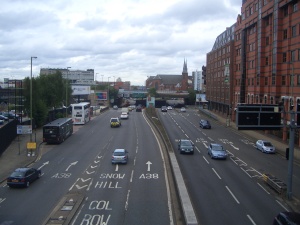



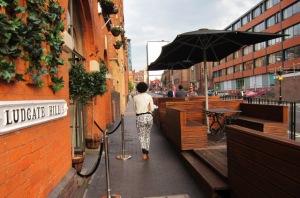



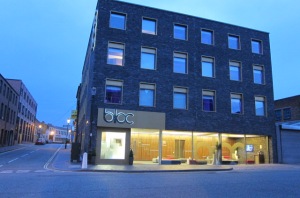

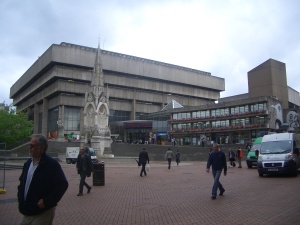


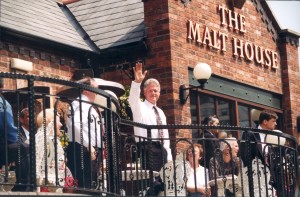





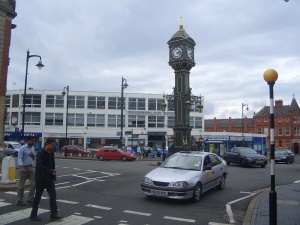

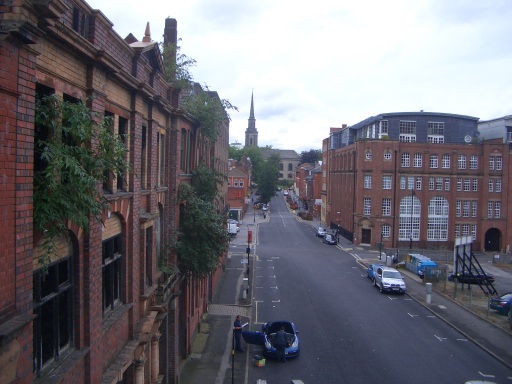
Thanks for your blog post. I found it had a refreshing candour that is often best minted by an ‘outsider’. There were one or two factual errors and missing bits but that is to be expected in a quick visit. I agree with you about not changing too much. When I first took the ‘job’ as Chair of the JQ Neighbourhood Forum – my first foray into ‘active citizenship’ – somebody asked me what the residents want in terms of regeneration. After noting the difficulty of one person knowing what 4000 people want, I said that my suspicions are that most people who live here want to find that middle ground between acres of industrial dereliction and acres of cheap nasty flats, with a plaque saying ‘The Jewellery Quarter Used to be Here’. I also agree about stopping the conveyor belt that seems to inevitably take couples to the suburbs when thoughts turn to sprogs and schools as well as your sentiment about business people being based here, as they would have been in the 18th C. To forge a new spirit of cooperation between people who live her and people who make a living here, we are 1/4 of the founding organisations of the JQ Development Trust, set up to replace the Council’s Regeneration Partnership, which fell victim to public spending cuts. The JQDT successfully balloted for the JQ BID you mentioned in your post and is just starting to run it.
The JQ was probably saved by the Conservation Area Management Plan back in the 80s. Local legend Marie Haddleton (still active at 84) was a force behind preventing the ‘blandification’ of the JQ. However, to some extent the CAMP has gone from being a life-line to a straight-jacket, preventing a real vision for a 21st Century JQ being developed. We had the Prince’s Foundation here to help us nearly a year ago, and their report had a number of useful suggestions on using planning and regeneration tools to get things moving – in the right direction and at the right pace. Their report is at http://bit.ly/STrhNH We are planning to use their suggestions to work with the planning authority to unlock a planning log-jam in a small area around Vittoria Street and Frederick Street, learn some lessons, and then look at wider application across the Quarter.
I found it hard to agree with your solutions to the traffic problems. Before running my own social enterprise (www.thewisdomfactory.org) I spent decades working in traffic/transport/safety and have a horror of using physical traffic calming (having inflicted them on many, many streets). On the other hand I’ve never seen convincing evidence that signs-only 20 MPH zones work. So I agree with the aspiration, but not the proposed solutions. I prefer a more incremental approach creating road environments where drivers feel less dominant (a la the late Hans Monderman in the Netherlands). It’s expensive so it has to be done when other changes are being made, or through planning gain (e.g. Albion Square in the JQ, Church Street Square in CBD).
Once again, thanks for taking the time to have a good look at the JQ (and wider Birmingham) and giving us some feedback.
Thanks so much for your feedback, and for the further info on the JQ and JQNF. It’s genuinely inspiring to see a group of people who are committed to a special place getting organised to maintain and enhance it.
I’m increasingly thinking that like Hebden Bridge, the JQ is a real-life role model of everything the Urban Repairs Club is in favour of. If we have a useful role (that’s an if!), it’s to try & shed light on how we can get neighbourhoods as enjoyable as the JQ in every town & city. Could JQ be replicated – not as a copy, but as a model of how to do it – in, say, Wolverhampton, or in Burnley’s Weavers Triangle? If it can, it will because of the people who believe in a place, and who want to be part of building a place which can offer them the lifestyle they want, a place a bit more interesting than the mainstream tends to offer.
I don’t think that such a place needs to be the exclusive preserve of the well-off – this perhaps needs a bit more thinking through to prove it, but I don’t see why an indie-economy/indie-lifestyle of the type advocated by Coffee Birmingham shouldn’t be a widely affordable choice.
In all events, the Urban Repairs Club will be plugging JQ as a place to visit to get inspired.
It’s the nature of internet discussion to focus on the 5% we disagree on than on the 95% we agree on, so I’ll just pick up the question of traffic calming. I’ve done something which is very poor netiquette and changed the text of the post you commented on, to clarify & respond to your comment. The suggested “urban repair” on planting street trees and traffic calming was meant to major on the idea of planting street trees to enhance the environment, with the idea that if they were used to narrow the existing roadway they might also have the additional beneficial effect of slowing the JQ’s traffic down. I wasn’t intending to suggest putting in speed humps across the area, and have altered the post to make that clearer.
Having said that, I must beg to differ about speed humps in general. As an outsider (specifically a London-based outsider) it jumps out to me that the JQ’s traffic goes far too fast and that too many driving through the JQ act like they own the road, and pedestrians should know their place and get the hell out the way. Dutch-style Monderman treatments are a possible ideal, but they can’t be done everywhere, not least because of the price. As the parent of kids I would say speed humps are the lesser of two evils compared to road casualties, and instead of appealing to boy racer & speed merchants’ better instincts to give a damn about others (which are not always there), they speak directly to their desire not to knacker their own car – and so are effective, good value and justified.
But that’s not my main point, which is, could street trees be used to deliver a kind of low cost Monderman-style outcome in the JQ?
I think I may have been a bit guilty of the 5% disagree/95% agree problem you mentioned. Street trees are in demand here, and the first one in decades went into the new Dayus Square (Albion Street/Camden Street) Monderman-style treatment this year. There is a proposal by BCC to put some in to the lower (wider) half of Caroline Street for aesthetic and traffic-calming effects. There has been plenty of research to show that vertical road-side features, be they trees or whatever, can have the effect of slowing traffic. Thank you for the vote of confidence in what JQNF and the JQ Development Trust are trying to achieve here.
Pingback: Should technology improve cities, or should cities improve technology? « The Urban Technologist
Quite an exhaustive article,Urbanrepairista, but I thoroughly enjoyed it even though you were maybe a little unkind in places. But you are right, the Jewellery Quarter is a very special place and hopefully will remain so for generations to come. I frequently cross the Great Charles Street barrier on a lunch hour to have a wander around and admire the architecture and narrow streets that are on offer, as well as enjoying the ‘buzz’ that the area generates.
It’s almost like another world from the business area in which I work but five minutes is all it takes and those who make the effort are well rewarded. Defenders such as Coffee Birmingham deserve plenty of support.
Great article! I agree, more trees are needed in the Jewellery Quarter! I would only add that the council should also consider the removal of tarmac from the smaller roads, which is a sports car’s wet dream, and replace this with cobble. This would slow down sports cars, attract the type of developers needed to redevelop the area and bring new tax revenues.